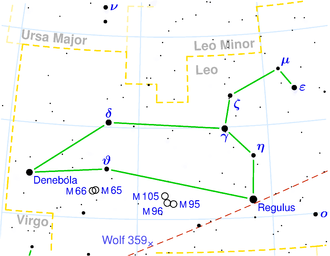IC 2569
| Galaxie IC 2569 | |
|---|---|
 | |
| SDSS-Aufnahme | |
| AladinLite | |
| Sternbild | Löwe |
| Position Äquinoktium: J2000.0, Epoche: J2000.0 | |
| Rektaszension | 10h 22m 53,6s[1] |
| Deklination | +24° 36′ 23″[1] |
| Erscheinungsbild | |
| Morphologischer Typ | E0[2] |
| Helligkeit (visuell) | 14,4 mag[2] |
| Helligkeit (B-Band) | 15,4 mag[2] |
| Winkelausdehnung | 0,3′ × 0,3′[2] |
| Flächenhelligkeit | 11,9 mag/arcmin²[2] |
| Physikalische Daten | |
| Rotverschiebung | 0.046369 ± 0.000087[1] |
| Radialgeschwindigkeit | (13.901 ± 26) km/s[1] |
| Hubbledistanz vrad / H0 | (618 ± 43) · 106 Lj (189,6 ± 13,3) Mpc [1] |
| Geschichte | |
| Entdeckung | Stéphane Javelle |
| Entdeckungsdatum | 26. März 1900 |
| Katalogbezeichnungen | |
| IC 2569 • PGC 1711559 • 2MASX J10225359+2436225 • GALEXASC J102253.50+243625.8 | |
IC 2569 ist eine linsenförmige Galaxie vom Hubble-Typ E0 im Sternbild Löwe an der Ekliptik. Sie ist schätzungsweise 618 Millionen Lichtjahre von der Milchstraße entfernt und hat einen Durchmesser von etwa 550.000 Lj.
Im selben Himmelsareal befinden sich u. a. die Galaxien NGC 3216 und IC 2567.
Das Objekt wurde am 26. März 1900 von Stéphane Javelle entdeckt.[3]
Weblinks
Einzelnachweise
Auf dieser Seite verwendete Medien
Autor/Urheber: Copyright © 2003 Torsten Bronger., Lizenz: CC BY-SA 3.0
This is a celestial map of the constellation Leo, the Lion.
Autor/Urheber: Sloan Digital Sky Survey, Lizenz: CC BY 4.0
The sky image is obtained by Sloan Digital Sky Survey, DR14 with SciServer.
Angle of view: 4' × 4' (0.3" per pixel), north is up.
Details on the image processing pipeline: https://www.sdss.org/dr14/imaging/jpg-images-on-skyserver/



